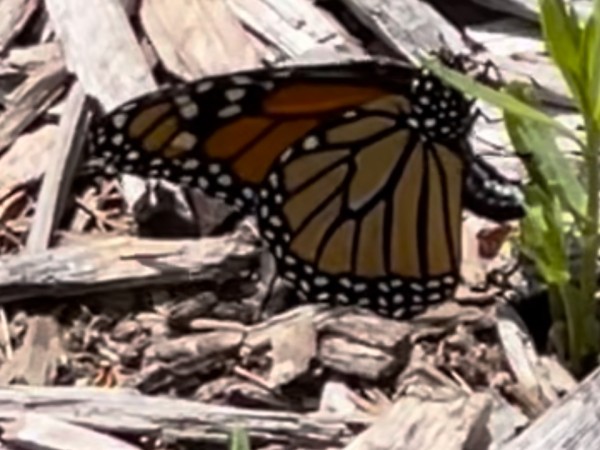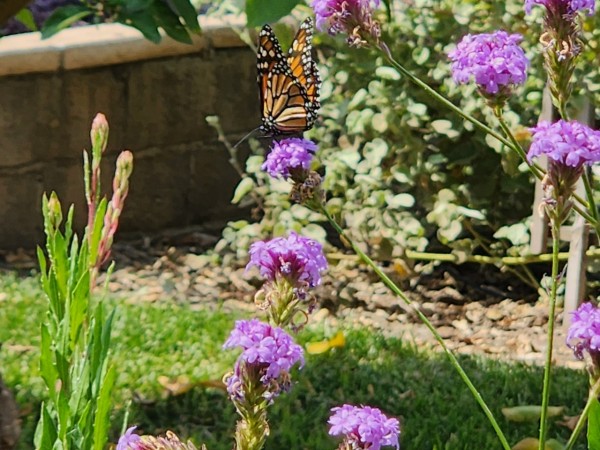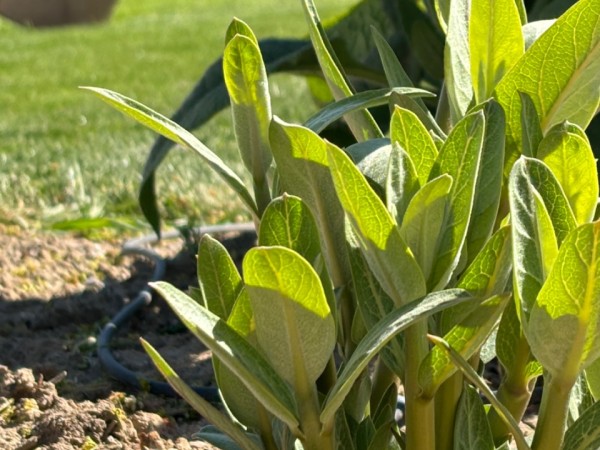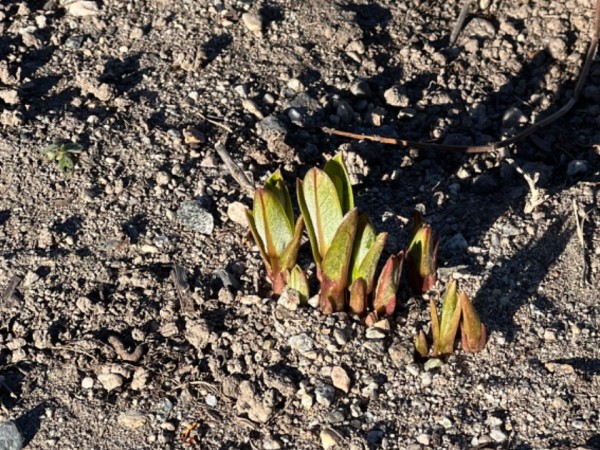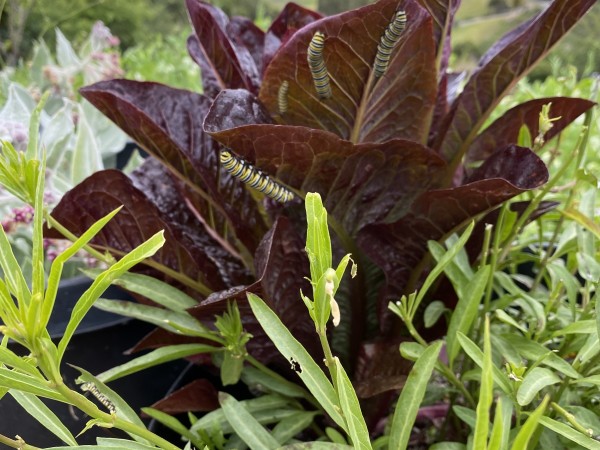2024 Spring Letter #6: Western Monarch population news From Gail Morris
Western Monarchs Update
Late-season rains swept through parts of California and the Pacific Northwest last week, while mountain snows blanketed the region accompanied by cooler-than-normal temperatures. Then, with whiplash speed, the weather is forecast to swing to above-normal temperatures with pockets of high winds in the upcoming days. The monarchs’ progress has been limited to California and Arizona, with recent reports of sightings in St. George, Utah, (without photo documentation). Will the blustery winds boost their flight to, Nevada, Utah or Oregon on their spring migration?
Recent Monarch Sightings
Here is a sample of monarch sightings during the last two weeks. Be sure to see our live maps for sightings around the West:
Brian lives in Los Angeles, California and found one monarch visiting a recently emerged milkweed with small leaves on May 3. “I can’t say for sure how many eggs she laid but she was all over our patch of narrowleaf milkweed down to the little satellite shoots that are coming up. I even have a video of her laying an egg while laying on her side because the plant wasn’t big enough to hold her weight.” When milkweed is scarce, female monarchs will lay eggs even on the smallest shoots. Will there be enough to feed hungry fifth instar larvae in the coming days?
Sometimes monarchs seem to be just passing through. Wellesley in Rancho Santa Margarita, California, found this very thing on May 5. A monarch is just “Cruising the garden. Didn’t stop.”
Bob spotted a solitary monarch flying around the milkweed (A. subulata) and nectar plants in his yard in Chandler, Arizona on May 4. “First one I’ve seen this spring.”
While we all wait eagerly for monarch sightings near the summer breeding fields, it’s comforting to see milkweed up and ready! Reports and photos submitted by Bradford in Salt Lake City, Utah, Bradford in Nampa, Idaho and all the way to Grant in Summerland, British Columbia show Showy Milkweed breaking ground to growing robustly and waiting for monarchs.
Grant in Summerland, British Columbia on April 20: “Showy milkweed emerged. This is a 2nd year plant. Two weeks ahead of 2023.”
Bradford in Nampa, ID, on April 27: “Planted May 1st 2021. Coming back strong. Showy milkweed. Grown from seed collected nearby.”
Bradford in Salt Lake City, UT, on April 26: “Asclepias speciosa. 50° Rain. Four year or older plant.”
From the Field
What is happening in California milkweed patches? You might be surprised and comforted to hear the news.
Monterey County, California
Scott Hennessy lives in Monterey County about 10 miles from the coast between Monterey and Salinas and has seen an amazing number of monarchs and their young this Spring.
“In mid March I was attending about a thousand containerized six month old Asclepius fascicularis (ASFA) emerging on a terrace in my garden when a female monarch appeared and began depositing eggs on the small plants. Since then and up to yesterday I have been visited nearly daily by a single female monarch, I don’t know if it has been the same one but the result has been that I have eggs, larvae, and chrysalis stages throughout my garden area on ASFA, ASCA3, ASER and ASCO. I have a rapidly growing set of ASFA though out my garden and I have had to spend much time taking the cats on the heavily grazed down containerized plants to lean the container up against the more substantial in ground ASFA plants. I expect I have over 100 cats throughout my planting. In past years I have had a few egg deposits in April but none for the last year. I recently moved about 4500 8 week old ASFA out of the greenhouse for their grow out and now they may host monarchs before they even get installed in projects in central California as the female was observed depositing eggs yesterday. The first wave of cats nearly consumed all of 200 young ASER after eating through their original ASFS host plants. I did find that the cats did not thrive on the young ASVE plants with some curling up and dying so I removed that species from their proximity. There are 10 observed chrysalises in the garden at the moment, so I expect to soon see adults. It’s been in the mid 40s at night and up to mid 60s during the day so the ‘production’ is slow.”
Be sure to see Scott’s photo! “An errant red Rosie lettuce plant hosting a bunch of cats, do they know it’s going to rain and sought shelter on the lettuce plant. No sign of nibbles on the head.”
Sacramento, California
Patti Farris lives in Sacramento, California, and is also is having a surprising Spring “Monarch” year.
“On March 19th, 2024 iNaturalist recorded a monarch laying eggs in the Midtown section of Sacramento. With high hopes, 25 ASFA plants in one gallon pots were placed in the front yard of my home in a prominent location. On Thursday, the 21st, lo and behold, 55 eggs were observed on the potted plants and ASSP coming up in the garden. Egg development was quite slow due to the cool weather: it took 13 days for most of the eggs to hatch! In the meantime, on April 16th, another monarch egg drop occurred; 20 eggs were found on potted plants, with a few larvae on plants in the ground. It is now May 2, and the first butterfly eclosed today. A total of 32 chrysalids were formed from batch #1, but most are still looking pretty green so it could be a while until they eclose. In the meantime, group #2 is munching away and looking good. Group #2 is developing faster than group #1, though it still took 8 days for the eggs to hatch. If you plant it, they will come….”
A special thank you to Scott Hennessy and Patti Farris for the contributions this week and to Dr. Tom Landis for his recommendations.
Send in your reports!
Monarch sightings are usually sparse this time of year as they lay eggs increasing the population on their migration to the summer breeding grounds. If you are lucky enough to see a monarch, please report your sighting of any adult, eggs or larvae to Journey North here. Your detailed description of what you see can include, but is not limited to, the monarch’s gender and activity. If known, include the type of flowers if they are nectaring or milkweed type if laying eggs. We also encourage you to report milkweed up! Photos are encouraged and welcomed with all your reports.
Gail Morris is the Coordinator of the Southwest Monarch Study (www.swmonarchs.org and the Western Monarch Advocates. She is also a Monarch Watch Conservation Specialist, and the Vice President of the Central Arizona Butterfly Association. The Western Monarch Population News is based on comments provided to Gail Morris. We hope to increase the number of sightings and therefore photos and comments entered into Journey North. We rely on the volunteers who communicate regularly with Gail and who agree to participate in our effort to increase awareness of the population of western Monarchs. You can reach her at gail@swmonarchs.org

